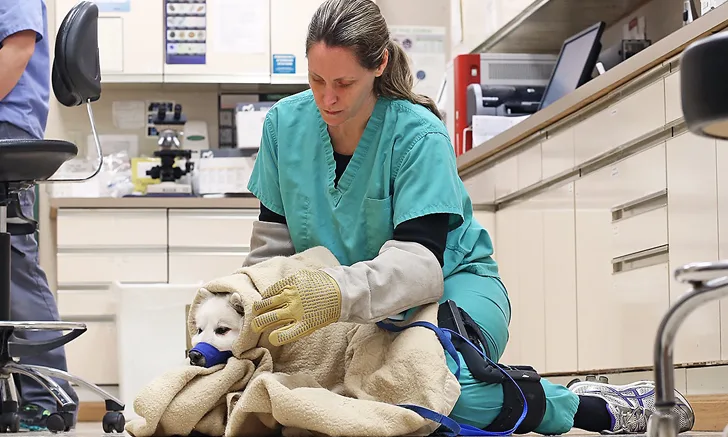Handling Aggressive Dogs
Marta Amat, DVM, PhD, DECAWBM, Universitat Autònoma de Barcelona
Tomàs Camps, DVM, PhD, DECAWBM, Universitat Autònoma de Barcelona
Camino García-Morato, DVM, MsC, Universitat Autònoma de Barcelona
Xavier Manteca Vilanova, DVM, PhD, DECAWBM, Universitat Autònoma de Barcelona

What is important to know about examining dogs that are exhibiting aggressive behavior?
Visits to the veterinarian are often stressful for dogs and owners—even more so when dogs exhibit aggressive behavior, which can make medical examinations more time-consuming and potentially dangerous.1-3
The most common reasons dogs are aggressive in the examination room include pain and fear.
The most common reasons dogs are aggressive in the examination room include pain and fear. For example, a dog with a painful ear infection can show aggression when the clinician tries to examine the ear. This behavior occurs because the dog is trying to avoid painful manipulation.3-6 If a dog has had negative experiences at the clinic or is poorly socialized with humans, it may be fearful and show aggression.3,6-8
Steps can be taken throughout the process to reduce stress for the patient and the veterinary team.
Related Article: Canine Fear-Related Aggression Toward Humans
Before the Appointment
Set appointments when the clinic is not expected to be busy, especially if the waiting room is small.
Advise the client to apply a calming pheromone spray on the cage or blanket 15 minutes before visiting the clinic.
Ask the client to minimize the time a fearful or painful patient spends at the clinic by waiting in the car or walking the dog until the appointment time.9
In the Waiting Room
Allow for a minimum distance between dogs of approximately the body length of the largest dog.9
Use a calming-pheromone diffuser to reduce the dog’s anxiety (can also be used in the examination room).2,10,11
Arrange the waiting room to limit contact with other species. Consider separate waiting areas for dogs and cats. If this is not possible, use a barrier (eg, towels, a room divider) to reduce visual contact between dogs and cats.8,9
Related Article: Aggressive Play in Dogs
In the Examination Room
Prepare materials needed for a consultation in advance.
Cover the examination table with a towel as most tables have a slippery, cold surface.8,9,12
Perform the examination on the floor if possible, depending on dog size and examination type; large dogs may feel more comfortable and secure on the floor.
If a dog reacts aggressively only in response to a given intervention (eg, examination of the ears), that intervention is best done at the end of the examination.
Other Stress-Reducing Tips
Reward the patient for calm, non-aggressive behavior.
Providing a morsel of a dog’s favorite food is an excellent reward as long as it is not medically contraindicated.8
Offer morsels of high-value food at regular intervals when the dog shows relaxed behavior.
A fearful dog with no prior history of aggression can display aggression; therefore, it is essential to identify signs of stress to minimize bite risk. Signs indicative of stress include displacement activities (eg, yawning, scratching, averting the eyes, licking lips); signs of fear (eg, agitation, panting, drooling, trembling, whining, escape attempts); and signs of aggression (eg, growling, baring teeth).3
Some dogs can react aggressively with no obvious warning signs.13 Team members should be educated about signs of stress in dogs and steps they can take to avoid eliciting aggression or fear.
Related Article: Assessing Risk & Prognosis in Aggressive Dogs
Precautions
Precautions should be taken while handling a dog that is fearful or exhibiting aggressive behavior.
Some behaviors should be avoided because they could be perceived as threatening. These include direct eye contact, frontal approach, reaching over the dog’s head, loud voices or high-pitched noises, sudden movements, petting the dog unless it demands it, and approaching too closely.3,9
Restraint methods can help prevent dog bites. Basket muzzles (Figure 1) are more comfortable for dogs and safer for the veterinary team than other muzzles; treats can be given through basket muzzles. A dog owner may be asked to provide a muzzle and to put it on at home, where the dog is more relaxed, provided the dog is not aggressive toward the owner. A habituation process can help the dog associate the muzzle with something positive.8,12
If the owner is not able to put the muzzle on the dog or if the dog belongs to a brachycephalic breed, a towel or inflatable collar can be used, along with other options in Figures 2-48,12:

Figure 1.
Food rewards can be given through the muzzle. Gaps in the muzzle can be enlarged so rewards can be given more easily.
Sedation
If the restraint methods described above are not adequate to allow for safe examination or if the dog’s welfare is seriously affected because it shows clear signs of stress, sedation may be advisable.3 The drug or drug combination can be chosen depending on the type of manipulation needed and the health of the dog. Acepromazine administration alone is not recommended, as it does not have any anxiolytic effect and makes the dog more sensitive to environmental stimuli.8,12 Sometimes the drug can be given at home orally 90 minutes before the appointment. Benzodiazepines are the most common drugs used for sedation, but they may increase aggressive behavior because of a paradoxical effect or a reduction of fear.14 Trazodone, a serotonin antagonist and reuptake inhibitor, could also be helpful. Nevertheless, 1 week is needed to observe the anxiolytic effect.
Once the client is home, a plan can be established to habituate the dog to stimuli associated with visiting the veterinarian. Habituation works best at an early age.8,9,12